|
|
|
FLUIDYNE PACIFIC CLASS GASIFIER The Pacific Class gasifier was designed to meet the specific needs of remote electric power generation in the tropical areas of the Pacific Ocean. Its final design requirement was conceived sitting on top of a hill 360° of very empty Pacific Ocean on the island of Atiu in the Cook Islands. In these places all the local people have is their environment,, still reasonably intact. Anything that comes into that environment of a technical nature must be reliable and in the case of a gasifier have no effluents that can pollute the ground water. Simplicity of servicing by the rural operators decreed that all systems be basic manual nut and bolt technology. Released for environmental testing in 1984, the first four units were sent to Fiji, Malaysia, South Africa and North America (Maine). In altitudes from sea level to 1500 feet, in temperatures from -15°C to 34°C, performance matched that established as a base line proven in New Zealand. Only 14 Pacific Class were built and supplied to projects in Fiji, Malaysia, South Africa, Indonesia, USA, Mozambique, Pitcairn Island, Papua New Guinea, Uruguay, UK and Germany. Haven taken seven years to develop the Pacific Class technology, the final design was winner of the industrial section of the (1984) New Zealand Steel Awards and outright winner (1984) of all categories entered. |
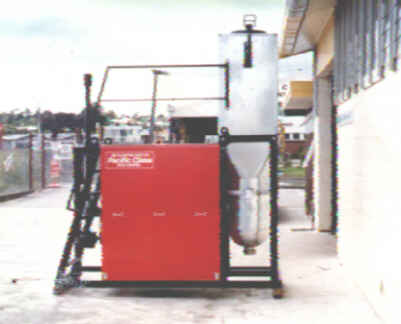 |
The Pacific Class wood gasifier is a complete package plant unit. Thermal insulation of the fuel hopper and gas making hearth module prevent heat losses and protects operators from hot surfaces. Hot components of the gas cooling section are enclosed behind opening panels. Built-in steps and hand rail provide the operator with easy access to the refuelling deck. Refuelling of the gasifier is manual with the wood fuel tipped into the fuel hopper by opening the safety spring loaded hatch lid. |
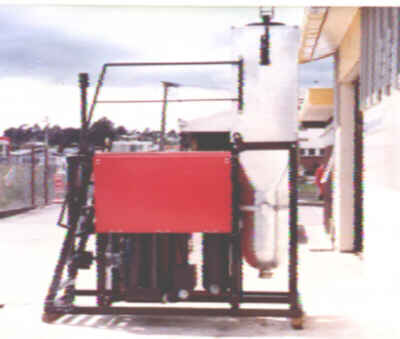 |
The side panelling covers the hot components acting as a duct to direct air from the fans over the hot surfaces, and out through the exit grill on the back side. The hot air discharge temperature varies with engine load on the gasifier and is typically 20-30 degrees C hotter than the ambient air at a flow rate of 6,000cfm. For cleanout servicing, the panel hinges upwards to expose the servicing ports. |
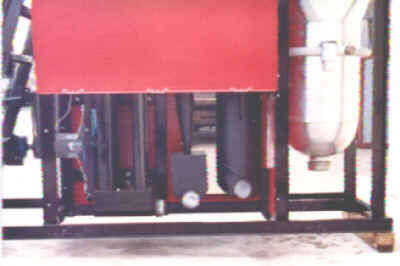 |
Daily servicing of the gasifier is a simple task made easy by the use of screw caps and taper threads. These hot clean-outs require no seals other than lubrication to the taper threads. Side opening panel duct cooling air over hot components and discharges hot air out through exit grill on rear side. |
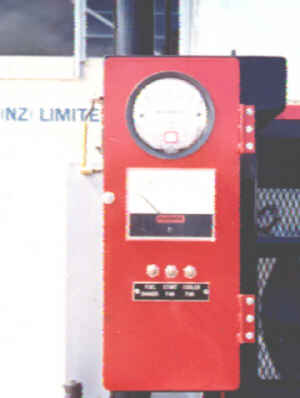 |
Instrumentation of the gasifier is basic and provides the operator with visual aids to the gasifier performance. The manometer provides pressure drop information from two sensor points, the hearth and filter. On the side of the instrument panel can be seen the yellow handle of the manometer two way control valve. Changes of pressure allows the operator to identify operational problems. A thermocouple in the blast tube measures gas temperatures and combined with the manometer, enables the operator to see if the gasifier is operating according to known operating conditions. This combination of instruments allows the operator to identify potential problems before the process is affected. Contained inside the control panel are the electrical components for the shaker fuel timer and electric motor switching. |
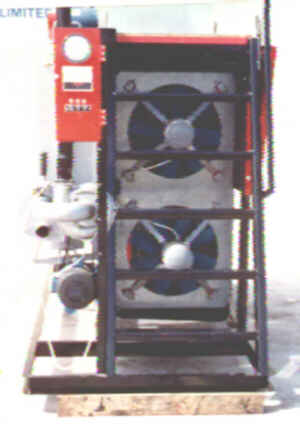 |
Cooling of the hot gas is by electrically powered twin fans. No water is used for gas cooling or cleaning. Condensate water from the gas contains no tar or other harmful contaminants. The condensate liquid is water containing some dissolved ash, small carbon particles, and has a P.H. of 8.2. This can change under certain conditions dependant on fuel wood and operating output. Under the instrument panel can be seen the electric start-up fan and gas changeover valve. |
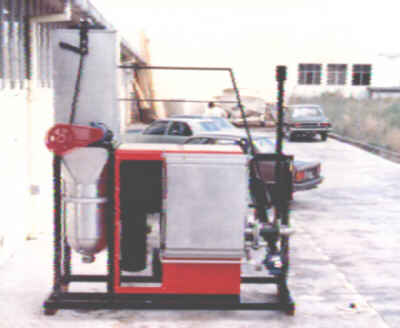 |
Rear view showing agitator motor, hot air exit grill, granular bed filter, startup fan and test flare stack |
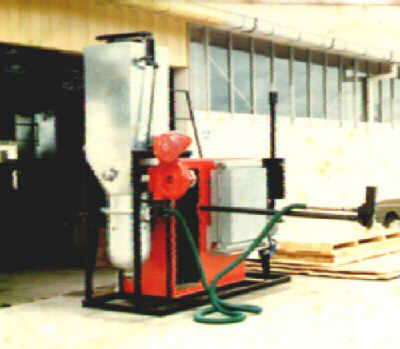 |
The Pacific Class gasifier design allows it to be used for process heat in the blown mode or engine application under suction. This dual purpose capability was conceived to meet the needs of institutional training programmes where both applications could be used and demonstrated in a practical manner. The burner nozzle on the end of the gas outlet pipe is the Cyclonix burner developed by Fluidyne for producer gas. |